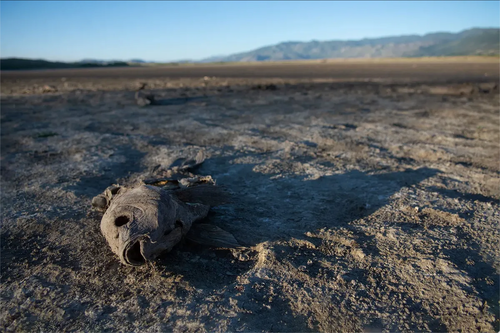
Utah's Great Salt Lake is facing unprecedented danger. Without a significant increase in water flow over the next several years, the lake might turn into dust. That's where things could get dangerous for the 2.5 million residents around the lake.
Recall we've already informed readers that declining water levels in the Great Salt Lake have created new challenges as dust laden with toxic metals threaten the region. It's just now the worsening megadrought in the western half of the US has brought forward what some folks refer to as an impending 'environmental nuclear bomb.'
In recent months, the lake level dropped to a historic low, exposing 800 square miles of lakebed that contain natural and artificial toxins, such as arsenic, mercury, and selenium.
As the drought situation deteriorates, the lakebed turns to dust and is whipped up into the air, which is ingested by the millions of residents surrounding it. Scientists told CNN the lake could evaporate within five years and trigger a "Great Toxic Dustbowl."
"This is an ecological disaster that will become a human health disaster," warned Bonnie Baxter, director of the Great Salt Lake Institute at Westminster College in Salt Lake City, Utah.
"We know about dust storms, we know about particulate pollution, we know about heavy metals and how they're bad for humans," Baxter told CNN. "We see a crisis that is imminent."
Here are the latest images showing the Great Salt Lake water levels in 1987 on the left and 2022 on the right.
Most alarming, if water inflows aren't increased naturally or artificially, then the air surrounding Salt Lake City will eventually turn poisonous. That development could severely impact the local economy. Let's hope that doesn't happen.
Utah’s Great Salt Lake is facing unprecedented danger. Without a significant increase in water flow over the next several years, the lake might turn into dust. That’s where things could get dangerous for the 2.5 million residents around the lake.
Recall we’ve already informed readers that declining water levels in the Great Salt Lake have created new challenges as dust laden with toxic metals threaten the region. It’s just now the worsening megadrought in the western half of the US has brought forward what some folks refer to as an impending ‘environmental nuclear bomb.’
In recent months, the lake level dropped to a historic low, exposing 800 square miles of lakebed that contain natural and artificial toxins, such as arsenic, mercury, and selenium.
As the drought situation deteriorates, the lakebed turns to dust and is whipped up into the air, which is ingested by the millions of residents surrounding it. Scientists told CNN the lake could evaporate within five years and trigger a “Great Toxic Dustbowl.”
“This is an ecological disaster that will become a human health disaster,” warned Bonnie Baxter, director of the Great Salt Lake Institute at Westminster College in Salt Lake City, Utah.
“We know about dust storms, we know about particulate pollution, we know about heavy metals and how they’re bad for humans,” Baxter told CNN. “We see a crisis that is imminent.”
Here are the latest images showing the Great Salt Lake water levels in 1987 on the left and 2022 on the right.
Most alarming, if water inflows aren’t increased naturally or artificially, then the air surrounding Salt Lake City will eventually turn poisonous. That development could severely impact the local economy. Let’s hope that doesn’t happen.
Loading…








